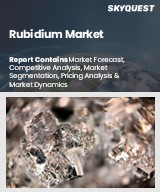
Report ID: SQMIG15A2566
SkyQuest Technology's Rubidium market size, share and forecast Report is based on the analysis of market data and Industry trends impacting the global Rubidium Market and the revenue of top companies operating in it. Market Size Data and Statistics are based on the comprehensive research by our Team of Analysts and Industry experts.
Global Rubidium Market size was valued at USD 4.8 billion in 2023 and is poised to grow from USD 5.08 billion in 2024 to USD 7.97 billion by 2032, growing at a CAGR of 5.8% during the forecast period (2025-2032).
The rubidium market, though relatively small in comparison to other alkali metals, is gaining attention due to its specialized and high-value applications. The growing utilization of this metal in scientific research, especially in the field of atomic clocks, is a key factor influencing the market positively. The increased adoption of 4G LTE and LTE-Advanced mobile network technology accelerates fiber telecommunication upgrades, positively impacting specialty glasses' production. Atomic clocks based on rubidium technology offer unparalleled precision in timekeeping, which makes them essential for various applications, such as satellite navigation, telecommunications synchronization, and fundamental physics experiments. It also plays a crucial role in advancing these scientific and technological frontiers.
However, one of the key challenges for the rubidium market is its restricted availability. Rubidium is not mined directly but is typically recovered as a by-product from lepidolite, pollucite, or other lithium-bearing minerals. This limited and geographically concentrated supply base, often centered in Canada, China, and select other regions, contributes to market volatility and supply risk.
How is AI Driving Precision and Efficiency in Rubidium Applications?
AI is significantly impacting the rubidium market, particularly in sectors like telecommunications, quantum computing, and medical diagnostics. One of the key areas where AI is driving innovation is in the use of rubidium atomic clocks for precise timekeeping in GPS systems and satellite communications. AI algorithms are enhancing the accuracy and efficiency of these systems by improving the synchronization and reducing errors in timing.
For example, in 2024, AI-based algorithms are helping optimize 5G networks, ensuring that rubidium-powered atomic clocks maintain seamless data transmission across vast distances. The increased demand for AI-driven solutions in telecommunications is making rubidium-based technologies even more essential for ensuring network synchronization and precise data transfer.
REQUEST FOR SAMPLE
Global Rubidium Market size was valued at USD 4.43 Billion in 2023 and is poised to grow from USD 4.67 Billion in 2024 to USD 7.11 Billion by 2032, growing at a CAGR of 5.4% in the forecast period (2025-2032).
In 2024, the global rubidium industry continues to evolve, shaped by strategic movements from key players focused on expanding production capabilities and tapping into emerging applications in healthcare, telecommunications, and quantum technologies. The competitive landscape is defined by both large established players and innovative newcomers seeking to capitalize on the growing demand for rubidium in various high-tech industries. 'Lepidico', 'Teledyne Technologies', 'Sinomine Resource Group', 'QuantumLeap Technologies', 'Rubidium Solutions', 'Albemarle Corporation', 'Sociedad Química y Minera de Chile (SQM)', 'American Elements', 'Lithium Americas', 'Cabot Corporation', 'Mitsubishi Corporation RtM Japan Ltd.', 'China National Chemical Corporation'
Rubidium's application in high-precision timekeeping devices, such as atomic clocks, is a major market driver. These clocks are critical for synchronization in GPS satellites, telecommunication networks, and scientific research. As the demand for accurate timing increases particularly in defense and aerospace so does the need for rubidium-based frequency standards. The rise in autonomous systems and 5G communications further supports this rubidium market trend by requiring ultra-reliable timing mechanisms.
Expansion of Rubidium Extraction from Lithium-Rich Resources: With rising global lithium exploration to support electric vehicle and battery industries, the incidental extraction of rubidium is becoming more feasible. Companies are increasingly targeting multi-element resource sites to enhance profitability. This co-extraction trend is helping mitigate rubidium’s supply chain limitations, reducing dependence on dedicated sources, and expanding its availability in the global market.
How are High-Tech Applications and Medical Innovations Shaping the Rubidium Market?
Want to customize this report? This report can be personalized according to your needs. Our analysts and industry experts will work directly with you to understand your requirements and provide you with customized data in a short amount of time. We offer $1000 worth of FREE customization at the time of purchase.
Feedback From Our Clients

Report ID: SQMIG15A2566
sales@skyquestt.com
USA +1 351-333-4748